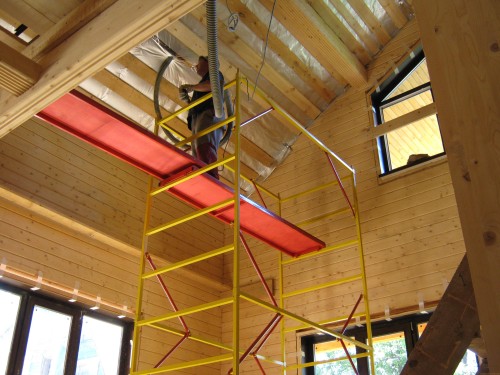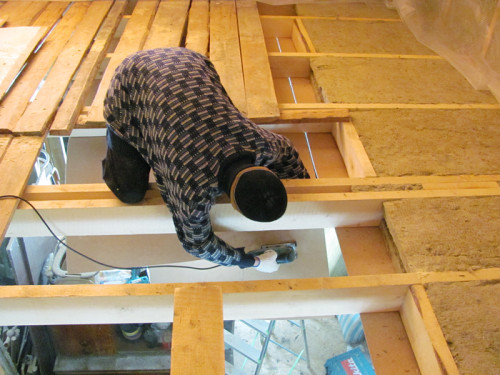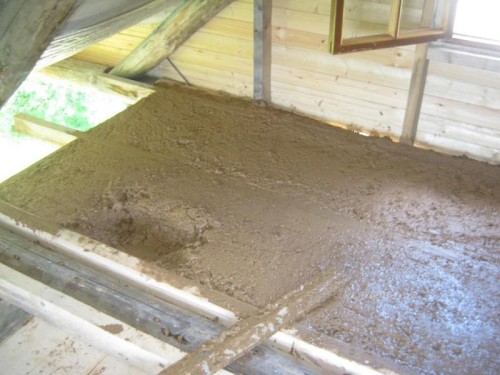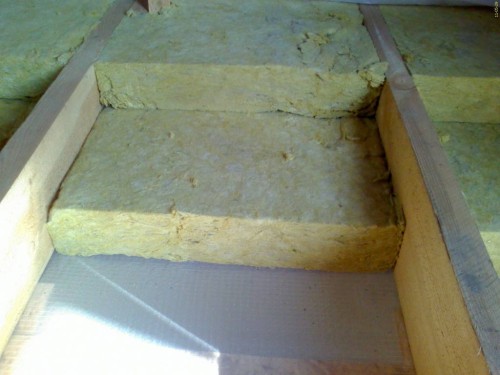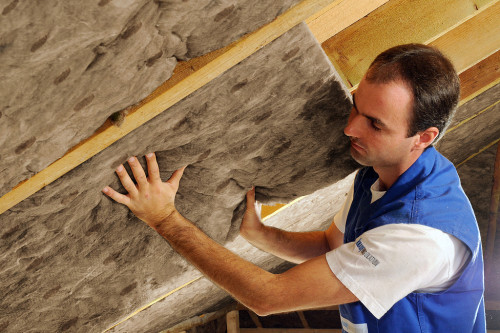
Wooden ceiling insulation: step-by-step instructions Ceilings
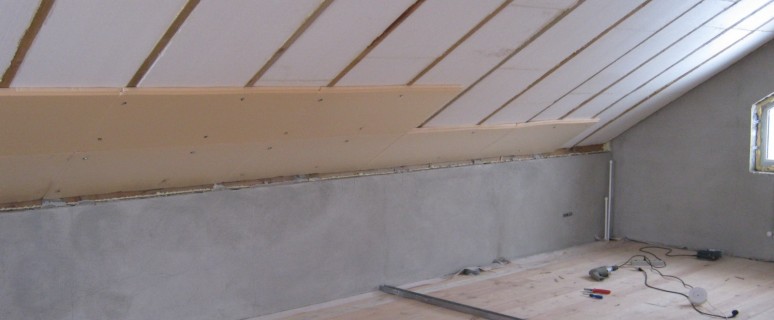
Despite the emergence of many new technologies in the construction industry, the demand for wooden houses does not decrease. This is explained by the fact that the buildings from the tree create a microclimate unique for humans. To achieve perfect comfort, thermal insulation works are conducted in the residential premises. Now we will tell about how to insulate a wooden ceiling.
Content
Heat insulation materials
The need for thermal insulation works is due to the fact that the maximum amount of heat is held by the ceiling. Therefore, if you do not insulate the ceiling, the heat insulation of the floor, walls, windows and doors will be practically useless.
When choosing a material for a wooden ceiling, various factors are taken into account:
- environmental purity;
- antistaticity;
- fire safety;
- resistance to temperature differences, etc.
The most important criterion in solving a dilemma, the better to insulate the wooden ceiling, are the insulating characteristics of the acquired material. Based on the above requirements, the best insulation for the ceiling of the wooden house are:
- sawdust;
- clay;
- styrofoam;
- mineral wool;
- polyurethane foam;
- penophol.
Preparatory work
Any work requires accurate calculations. Before the heat insulation of the wooden ceiling, you should pay attention to:
- maximum and minimum temperature regimens inside the house and on the street;
- constructive features of the ceiling and roof of the building;
- coefficients of heat transfer of all thermal insulation elements;
- the quality of the insulation.
Based on the calculations carried out, the optimal thickness of the thermal insulation layer and the number of acquired materials are determined.
In addition to holding calculations, the preparatory stage includes laying a vapor barrier material. For these purposes, it is quite suitable:
- ordinary polyethylene film;
- pergamine;
- films with a rough surface.
The main purpose of the vapor barrier is the protection of building structures from condensate and holding up heat rising. Vapor insulation material should fit tightly to beams. Otherwise, the "cold bridges" will arise, through which heat will leave from the house.
Ceiling insulation nuances
Wooden ceiling insulation can be carried out both inside the dwelling and the attic. With internal insulation, it should be considered that the height of the rooms will significantly decrease. Thermal insulation work on the side of the attic room includes the subsequent device of the floor covering.
Consider the main types of ceiling insulation in a wooden house using various materials.
Sawdust for ceiling insulation
This material is used to insulate the ceiling from the outside. Speakers are presented with certain requirements. They should be:
- dry;
- odorless mold;
- not too small;
- stray (at least one year).
For insulation, the ceiling is made a mixture consisting of:
- sawdust (60 hours);
- water (9 hours);
- cement (1 hour).
With the correct kneading solution, it turns out a grayish color. It should be without lumps and quickly stick. To determine the required amount of the mixture, the treated area should be divided into number 5. For example, if we need to insulate a ceiling with an area of \u200b\u200b60 m², then the solution will be needed 12 m³ (60: 5).
The process of wood ceiling insulation using sawdust provides such sequential steps:
- surface treatment with antifungal agent;
- flooring a vapor insulation film;
- pouring, tamping and alignment of the solution;
- from the mixture should be removed all air.
Heat insulation works are recommended in summer. The whole moisture contained in the cement-sawing solution should evaporate. As a result of the insulation, the ceiling should be a surface that is not presented and makes a specific crunch when walking on it.
Clay for ceiling insulation
This insulation is the most ancient. Also used in combination with other materials (sawdust and parchment). This is explained by the fact that to achieve effective thermal insulation, the layer of stacked clay should exceed 0.5 m.
The mortar from the clay will take the minimum amount of time. The easiest way to prepare is the use of a big barrel. Water poured into the container and clay is poured.
After thorough mixing of clay with water, the resulting solution is transfused into the concrete mixer. Speakers are added to the solution. Water is added as needed. As a result, a mixture of medium density should turn out.
The insulation of the ceiling clay suggests:
- laying pergamine;
- applying a solution with a 15-centimeter layer;
- after drying, rubbing cracks clay.
Polyfoam for insulation ceiling
It has exceeded thermal insulation and sound insulation. Polyfoam does not rot and is environmentally safe. Among the disadvantages of the material should be mentioned about the fragility and that it can eat rodents.
The foam installation technology on a wooden ceiling includes:
- parchment flooring;
- tight laying of foam plastic for parchment;
- fixing the insulation with wooden slats;
- filing of clay crumbs;
- sealing the remaining gaps by mounting foam.
Mineral wool for insulation
The most demanded material of our time. Used as both insulation and soundproofing material. Mineral wool does not absorb moisture and absolutely fireproof. Laying the insulation can be carried out inside a wooden house, and from an attic side.
Mounting mineral wool consists of such steps:
- fastening of vapor barrier material;
- laying foam;
- close up of foam of seams available between polyfoam sheets;
- fixation of another layer of vaporizolation;
- installation of two layers of insulation.
For reliable fastening of mineral wool, nails and rails are used. Laying the thermal insulation material is carried out as tight as possible. There should be no cracks through which heat will come out.
Polyurethane foam for ceiling insulation
Modern insulation has:
- magnificent heat-insulating properties;
- resistant to temperature differences;
- the inconsistency of the burning and negative influence of insects and microorganisms.
The lack of polyurethane foam is a steam resistant.
The insulation technology of the ceiling polyurethane foam assumes implementation:
- surface preparation;
- spraying material;
- reinforcement ceiling.
The surface preparation is to remove the old coating. Polyurethane foam must effectively conclude with the ceiling. A fiberglass network with small cells is used as a reinforcing coating.
Penophol for ceiling insulation
This insulation is effective in the case when there are no heavy heat losses in the house. One of the sides of the foam is foil.
Wooden ceiling insulation provides:
- cutting device;
- fastening the insulation to the crate with nails;
- the foil part is sent to the ceiling;
- the foam is covered by another frame designed for finishing coating.
The foofol is an indispensable material when the surface is subsequent with suspended ceilings or clapboard.
Several ceiling warming tips
In order for thermal insulation work to be carried out high quality and in a short time, it is necessary to take into account several nuances.
These include:
- The purchase of thermal insulation material and fasteners is made with a reserve of 10-15%.
- Outdoor insulation is the most efficient.
- With a weak use of the attic room, the bulk insulation does not need to be covered with waterproofing material.
- Polyfoam is necessarily covered with a film, because in the outdoor is subject to destruction.
- With thermal insulation, the ceiling by the attic laying of the insulation begins near the chimneys and other designs.
- When the ceiling insulation, the ceiling should be carried out in advance of the installation of communication lines: electrical wiring, cable for the Internet, ventilation channel.
Checking performed work can be carried out in two ways:
- immediately after laying insulation;
- in winter.
The first option is to heat the whole house. After that, the temperature is measured in all rooms and all windows and doors are closed for 5-6 hours. If in some of the rooms compared to other temperatures dropped significantly, this indicates the mistakes allowed.
Naturally, this check disappears in the case of hot weather. In this case, the check is better to spend in winter. When the snow falls out, the roof is inspected. The presence of a uniform layer of snow speaks of high-quality laying of the insulation.
Video about Wooden ceiling insulation:




